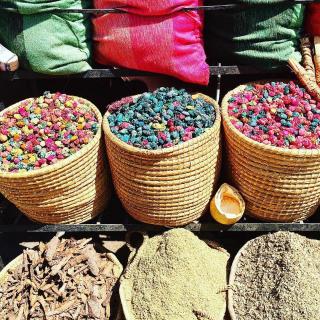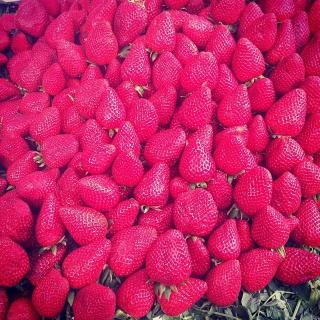Must-try Dishes
Harira - Moroccan Soup (hearty soup) - A blend of tomatoes, lentils, chickpeas, and spices, this soup is thick and comforting, served with a squeeze of lemon. Typically enjoyed during Ramadan for iftar, it’s a communal dish and feels like a warm hug.
B'stila - Chicken Pie (savory pie) - This exquisite dish features spiced chicken wrapped in flaky pastry and topped with powdered sugar and cinnamon, providing a surprising sweet-savory mix. Locals enjoy it at special occasions or family gatherings, and it’s often a highlight at weddings.
Tajine - Slow-Cooked Stew (traditional stew) - A fragrant stew made from meat (like chicken or lamb), vegetables, and a medley of spices, slow-cooked in a clay pot. Best shared during family dinners, this communal style of eating reflects Moroccan hospitality, and you can often taste the love infused in every bite.
Mechoui - Whole Roasted Lamb (roasted meat) - This whole lamb is seasoned and roasted to perfection, resulting in tender, flavorful meat that is typically enjoyed during celebrations. Locals often eat it in large groups; trust me, sharing makes it even more delicious.
Mrouzia - Spiced Lamb Tagine (sweet-spicy tagine) - A unique blend of lamb, honey, and almonds cooked to perfection, it embodies the contrasting flavors of sweet and savory that Moroccan cuisine is known for. This dish is generally served during Eid and reflects the country’s culinary diversity.
Pastilla au Poisson - Fish Pie (fish pastry) - Similar to B’stila but filled with spiced fish and nuts, this dish showcases the coastal flavors of Morocco. It’s more of a rare find in homes, often enjoyed during special occasions, surprising visitors who come expecting just meat-filled versions.
Khobz - Moroccan Bread (traditional bread) - Freshly baked, this bread is dense and slightly crusty, perfect for scooping up various stews and tagines. Most locals eat it with every meal, so be sure to grab some to complete any dish.
By the way, don’t forget to watch how locals break bread—torn pieces are shared, emphasizing the communal aspect of meals in Marrakech.
Desserts & Drinks
Mint Tea - Thé à la Menthe (sweet, refreshing tea) - A fragrant blend of green tea, fresh mint, and a generous amount of sugar, often served in ornate glasses. Locals enjoy this tea multiple times throughout the day, especially when welcoming guests – it’s a symbol of hospitality.
Fresh Orange Juice - Jus d'Orange (citrusy delight) - Bright, sweet orange juice squeezed fresh from Marrakech’s own ripe oranges and served in a chilled glass. Best enjoyed as a refreshing pick-me-up during hot afternoons, you might find street vendors hawking it near bustling markets.
Rooibos Infusion - Infusion de Rooibos (herbal drink) - Made from the South African rooibos plant, this naturally caffeine-free drink is typically brewed and served hot, sometimes with a drizzle of honey. It's a favorite in colder months and can be found in many homes during gatherings.
Patisserie - Pastilla Sucrée (sweet pastries) - A delicate flaky pastry filled with layers of nuts, often flavored with cinnamon and sugar, served warm. Traditionally, locals eat it during special occasions, such as weddings, where its sweet and savory juxtaposition makes it a crowd-pleaser.
Ice Cream - Glace Artisanale (gourmet ice cream) - Creamy, unique flavors like rosewater or dates made from the freshest local ingredients, served chilled. You’ll find ice cream stalls buzzing during the summer evenings, loved by both locals and visitors looking for a cool treat after a day in the hustle and bustle.
By the way, if you’re at a local café, don’t be surprised if your tea is served in a small, decorative pot – it’s part of the charm! Remember to drink slowly and enjoy the conversation; it’s all part of the experience!



